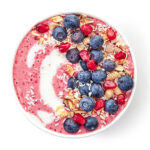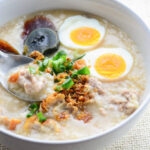Soya Chunks Wrap is a delightful fusion dish that combines the goodness of protein-rich soya chunks with an array of flavorful spices and fresh vegetables, all neatly wrapped in a soft tortilla or flatbread. Soya chunks, also known as textured vegetable protein, serve as the primary ingredient, offering a meaty texture and a significant source of plant-based protein. This versatile wrap typically features a tantalizing mix of sautéed soya chunks seasoned with aromatic spices, such as cumin, coriander, and turmeric, along with a vibrant medley of finely chopped vegetables like onions, tomatoes, and bell peppers. The filling is carefully encased in a warm tortilla or flatbread, creating a convenient handheld meal that’s perfect for any occasion. Soya Chunks Wraps are not only delicious but also provide a nutritious option for those seeking a plant-based alternative or simply looking to add more protein to their diet.
| Ingredients | |
| 1 | 1 cup soya chunks |
| 2 | 1 onion, finely chopped |
| 3 | 1 tomato, finely chopped |
| 4 | 1/2 cup bell peppers (any color), thinly sliced |
| 5 | 1/4 cup shredded lettuce or cabbage |
| 6 | 2-3 tablespoons cooking oil |
| 7 | 1 teaspoon cumin seeds |
| 8 | 1 teaspoon ginger-garlic paste |
| 9 | 1/2 teaspoon turmeric powder |
| 10 | 1 teaspoon coriander powder |
| 11 | 1/2 teaspoon cumin powder |
| 12 | 1/2 teaspoon garam masala powder |
| 13 | Salt to taste |
| 14 | 4-6 tortillas or flatbreads |
| 15 | Optional: chopped cilantro for garnish |
| 16 | Optional: grated cheese |
| 17 | Optional: yogurt or sour cream for serving |
| 18 | Optional: hot sauce or salsa for serving |
Step-by-step cooking instruction of Soya Chunks Wrap:
Step-1 Prepare the Soya Chunks:
- In a pot, bring the water to a boil.
- Add the soya chunks to the boiling water and cook for about 5-7 minutes, or until they become soft and tender.
- Drain the cooked soya chunks and rinse them with cold water to remove any excess starch or impurities. Squeeze out excess water and set aside.
Step-2 Cook the Filling:
- Oil should be heated in a pan over medium heat.
- Splutter the cumin seeds after adding them.
- Finely chop the onions and sauté them until they become transparent.
- After adding the ginger-garlic paste, sauté for an additional minute, or until the raw scent is gone.
- Cook the diced tomatoes until they are mushy and tender.
- Once the bell peppers are slightly soft, add the slices and simmer for a few minutes.
- Stir in the salt, coriander, cumin, turmeric, and garam masala powders. Blend thoroughly.
- Add the cooked soya chunks to the pan and mix until they are well coated with the spices. Cook for another 5-7 minutes, stirring occasionally.
Step-3 Assemble the Wraps:
- Warm the tortillas or flatbreads slightly on a griddle or in a microwave to make them pliable.
- Place a spoonful of the prepared filling in the center of each tortilla.
- Top with shredded lettuce or cabbage.
- Optionally, sprinkle grated cheese and chopped cilantro over the filling.
- Roll the tortillas tightly to form wraps, tucking in the sides as you roll.
Step-4 Serve:
- Serve the Soya Chunks Wraps hot with yogurt or sour cream and hot sauce or salsa on the side, if desired.
- You can also wrap them in foil for a convenient on-the-go meal option.
Nutritional values of Soya Chunks Wrap:
The nutrition values of a Soya Chunks Wrap can vary depending on factors such as the specific ingredients used, portion sizes, and any additional condiments or toppings. However, here’s a general overview of the nutritional components you might expect from a typical Soya Chunks Wrap:
Nutritional Values Per Serving (approximate):
| 1 | Calories: Around 250-300 calories per wrap (this can vary based on tortilla size and filling ingredients). |
| 2 | Protein: Soya chunks are a significant source of plant-based protein, providing approximately 15-20 grams of protein per serving. |
| 3 | Carbohydrates: Approximately 30-40 grams of carbohydrates, primarily from the tortilla or flatbread and any vegetables used in the filling. |
| 4 | Fat: The fat content can vary depending on factors like cooking oil and cheese. Typically, it might contain around 10-15 grams of fat per serving, with variations based on ingredients. |
| 5 | Fiber: Soya chunks and vegetables contribute dietary fiber, offering approximately 5-8 grams per serving, aiding in digestion and promoting a feeling of fullness. |
| Vitamins and Minerals: Soya chunks are rich in various vitamins and minerals, including iron, calcium, magnesium, and vitamin B12. Additionally, vegetables like bell peppers, tomatoes, and lettuce provide vitamins A, C, and K, as well as potassium and folate. |
Background History of Soya Chunks Wrap
The history of Soya Chunks Wraps is intertwined with the evolution of plant-based cuisine and the increasing popularity of soy-based products in various culinary traditions. While the specific origin of Soya Chunks Wraps may not be well-documented, we can trace their development through several key historical trends:
Soybean Cultivation and Consumption: Soybeans have been cultivated in East Asia for thousands of years and have played a significant role in Asian cuisine, particularly in countries like China, Japan, and Korea. Soy products such as tofu, tempeh, and soy sauce have been staples in these cultures for centuries.
Rise of Soy-Based Meat Substitutes: In the 20th century, as interest in vegetarianism and veganism grew worldwide, there was a demand for meat alternatives. This led to the development of soy-based meat substitutes, including textured vegetable protein (TVP) or soya chunks. These products gained popularity for their high protein content and versatility in cooking.
Global Fusion Cuisine: With increased globalization and cultural exchange, culinary traditions from different parts of the world began to merge. Wraps, which are essentially portable, handheld meals, gained popularity as a convenient and customizable option in many cultures.
Health and Sustainability Concerns: As concerns about health, animal welfare, and environmental sustainability grew, more people started seeking plant-based alternatives to meat. Soya Chunks Wraps emerged as a nutritious and sustainable option, providing a source of protein without the environmental impact associated with meat production.
Creative Culinary Innovation: Chefs and home cooks alike began experimenting with different ingredients and flavor combinations to create innovative plant-based dishes. Soya Chunks Wraps became a canvas for creativity, allowing for endless variations with spices, vegetables, sauces, and condiments.
Today, Soya Chunks Wraps are enjoyed by people around the world as a tasty, nutritious, and convenient meal option. They reflect the ongoing shift towards plant-based eating and the desire for flavorful, satisfying dishes that are also environmentally friendly. As the demand for plant-based foods continues to grow, Soya Chunks Wraps are likely to remain a popular choice for those seeking delicious and sustainable meal options.
| Advantages of Soya Chunks Wrap | |
| 1 | High Protein Content: Soya chunks are a rich source of plant-based protein, making Soya Chunks Wraps an excellent option for vegetarians and vegans looking to meet their protein needs. |
| 2 | Nutrient Dense: Iron, calcium, magnesium, B vitamins, and other vital elements are all found in abundance in soya chunks, which promote general health and wellbeing. |
| 3 | Versatility: Soya Chunks Wraps can be customized with a variety of vegetables, sauces, and condiments, allowing for endless flavor combinations to suit different tastes and preferences. |
| 4 | Convenient: Wraps are portable and easy to eat on-the-go, making Soya Chunks Wraps a convenient option for busy individuals or as a packed lunch. |
| 5 | Health Benefits: The inclusion of vegetables in Soya Chunks Wraps adds vitamins, minerals, and dietary fiber, promoting digestive health and providing a range of other health benefits. |
| Disadvantages of Soya Chunks Wrap | |
| 1 | Allergies: Some individuals may have soy allergies, which can cause adverse reactions when consuming Soya Chunks Wraps. It’s important to be mindful of allergens when preparing and serving these wraps. |
| 2 | Processing: Soya chunks are processed soy products, and some people prefer whole food sources over processed alternatives. Additionally, commercially available soya chunks may contain additives or preservatives, which can be a concern for some individuals. |
| 3 | Texture: While many people enjoy the texture of soya chunks, others may find it too chewy or firm for their liking. Texture preferences can vary among individuals, so some may not enjoy the mouth feel of Soya Chunks Wraps. |
| 4 | Sodium Content: Depending on the seasoning and sauces used, Soya Chunks Wraps may contain high levels of sodium, which can contribute to health issues like high blood pressure or cardiovascular disease if consumed in excess. |
| 5 | Environmental Concerns: While soya chunks themselves are plant-based and environmentally friendly compared to meat, there are environmental concerns associated with soy cultivation, such as deforestation and habitat destruction. It’s essential to consider the sourcing of soy products for sustainability. |
Compare with Similar meal of Soya Chunks Wrap:
Similar meals to Soya Chunks Wraps include:
| 1 | Tofu Wraps: Replace the soya chunks with tofu, another popular soy-based protein. Season and cook the tofu similarly to the soya chunks, then wrap it in a tortilla with vegetables and sauces of your choice. |
| 2 | Tempeh Wraps: Tempeh is another soy-based product made from fermented soybeans. Marinate and cook tempeh slices before wrapping them in a tortilla with vegetables and condiments. |
| 3 | Chickpea or Bean Wraps: Use mashed or seasoned chickpeas, black beans, or kidney beans as the protein base for your wraps. Mix them with spices, vegetables, and sauces before wrapping in a tortilla. |
| 4 | Vegetable and Hummus Wraps: For a lighter option, fill tortillas with a variety of fresh vegetables like lettuce, cucumbers, tomatoes, bell peppers, and carrots, along with hummus for added flavor and protein. |
| 5 | Quinoa or Grain Wraps: Cooked quinoa or other grains like brown rice, barley, or bulgur can serve as a nutritious base for wraps. Mix them with vegetables, herbs, and a dressing or sauce before wrapping in a tortilla. |
| 6 | Eggplant or Mushroom Wraps: Sautéed or grilled eggplant slices or mushrooms can provide a meaty texture and savory flavor to wraps. Pair them with roasted vegetables, greens, and a creamy sauce for a delicious vegetarian option. |
| 7 | Falafel Wraps: Stuff warm falafel balls into a tortilla with lettuce, tomatoes, cucumber, tahini sauce, and pickled vegetables for a flavorful Middle Eastern-inspired wrap. |
Mostly questions asked about Soya Chunks Wrap
1: What are Soya Chunks?
A: Soya chunks, also known as textured vegetable protein (TVP), are defatted soy flour products that have been processed into granules or chunks. They are a popular meat substitute and are rich in protein.
2: Are Soya Chunks Healthy?
A: Yes, soya chunks are considered healthy as they are low in fat, rich in protein, and contain essential nutrients such as iron, calcium, and B vitamins. They are a good source of plant-based protein for vegetarians and vegans.
3: How to Cook Soya Chunks for Wraps?
A: To cook soya chunks for wraps, first rehydrate them by soaking in hot water for about 10-15 minutes. Drain the water and squeeze out excess moisture. Then, season and cook them in a pan with spices and vegetables until tender and flavorful.
4: What Vegetables Can I Use in Soya Chunks Wraps?
A: You can use a variety of vegetables in Soya Chunks Wraps, such as onions, bell peppers, tomatoes, lettuce, cabbage, carrots, cucumbers, and spinach. You are welcome to alter the filling to suit your tastes.
5: Can I Make Soya Chunks Wrap in Advance?
A: Yes, you can prepare Soya Chunks Wraps in advance by cooking the filling and assembling the wraps. For up to one or two days, keep them refrigerated in an airtight container. Warm them in the microwave or oven before serving.
6: Are Soya Chunks Wraps Suitable for Weight Loss?
A: Soya Chunks Wraps can be a part of a weight loss diet as they are low in calories and rich in protein and fiber, which can help keep you full and satisfied. However, be mindful of portion sizes and the ingredients used for filling.
7: Can I Freeze Soya Chunks Wrap?
A: While you can freeze Soya Chunks Wraps, it’s best to freeze the filling separately from the tortillas to prevent them from becoming soggy. Thaw the filling and assemble the wraps just before serving for the best texture.
8: What Sauces Can I Use in Soya Chunks Wraps?
A: You can use a variety of sauces in Soya Chunks Wraps, such as salsa, guacamole, hummus, tahini, yogurt-based sauces, hot sauce, or barbecue sauce. Choose your favorite sauce to add flavor and moisture to the wraps.
9: Are Soya Chunks Wraps Gluten-Free?
A: Soya Chunks Wraps can be made gluten-free by using gluten-free tortillas or flatbreads. Ensure that all other ingredients, including spices and sauces, are also gluten-free if you have a gluten intolerance or allergy.
10: Are Soya Chunks Wraps Suitable for Kids?
A: Yes, Soya Chunks Wraps can be a nutritious and kid-friendly meal option. You can customize the filling with kid-friendly vegetables and mild spices to suit their taste preferences. Ensure that the wraps are cut into smaller portions for easier handling by children.







